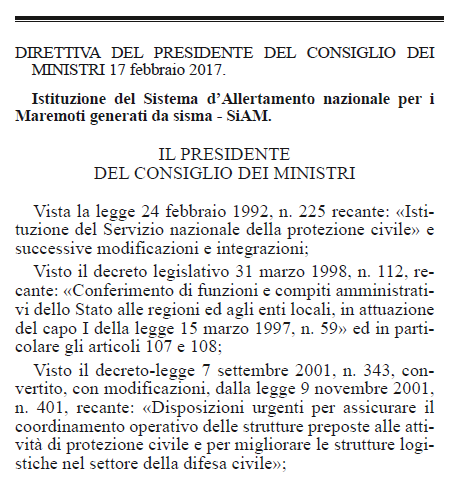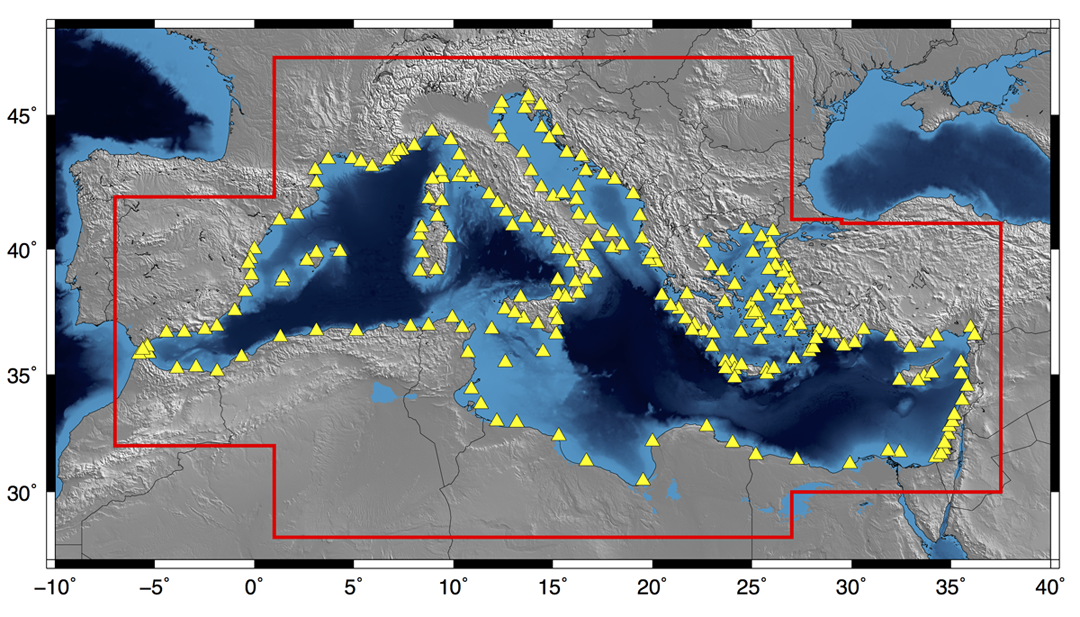 An excerpt from the Directive published in the Official Journal;
An excerpt from the Directive published in the Official Journal;The National Alert System for Tsunami wave generated by earthquakes in the Mediterranean Sea (SiAM), includes the Italian Civil Protection Department (DPC) which also performs coordination functions, the Tsunami Alert Centre of the INGV-National Institute of Geophysics and Volcanology (CAT-INGV) and the Italian Institute for Environmental Protection and Research (ISPRA).
Its aim is to monitor and analyse in real time the data from the monitoring networks, for twenty-four hours a day and seven days a week, in order to detect earthquakes at sea or along the coast, to assess the possibility that they could generate tidal waves and to disseminate early alert messages. The SiAM system ran on an experimental basis from 2014 to 2016, but was formally established by the Directive of the President of the Council of Ministers dated 17 February 2017, and published in the Official Journal (no 128 dated 05-06-2017). The directive defines the tasks and functions of the subjects involved, attributing to the Italian Civil Protection Department the role of coordination and the task of issuing alerts should an event occur.
To date, the knowledge and technologies available only allow monitoring tsunamis caused by earthquakes and do not allow operating on other possible sources of a tsunami, such as landslides, volcanic eruptions, weather phenomena, etc. Tsunamis of seismic origin account for about eighty per cent of known events, as well as being the most extensive.
The alert system consists of three basic activities.
The first includes seismic monitoring, carried out by the Tsunami Alert Centre of the INGV, which detects earthquakes with an epicentre in the sea or in the immediate vicinity, assesses the possibility that a particular earthquake may generate a tsunami, estimates the arrival time of the wave along the exposed coasts and, as quickly as possible, communicates the alert to the Italian Civil Protection Department.
The second phase provides for the dissemination of alert messages by the DPC to the structures and components of the national Civil Protection service with the aim of also reaching, in the shortest possible time, the potentially affected population.
The third activity of SiAM consists in analysing the data from the tidal gauge networks present in the Mediterranean, including the national tide gauge network (NTGN) managed by ISPRA, which allows to detect the occurrence of anomalies in the sea level at the various detection stations, thereby confirming or not the arrival of any seaquake wave. These data are analysed in real time by the CAT-INGV for confirmation and quantification of the magnitude of the tsunami, or vice versa to cancel the issued alert, if the instruments do not detect any anomaly in the sea level.
The SiAM monitoring area covers all the coasts of the Mediterranean and extends from one hundred km west of the Strait of Gibraltar to the Sea of Marmara, embracing the coasts of twenty countries. In its capacity as Tsunami Service Provider of the ICG/NEAMTWS, the CAT-INGV also sends warning messages to several Mediterranean countries, in particular to agencies and institutions in Cyprus, Egypt, Germany, Israel, Lebanon, Malta, Spain, with the future objective of covering all countries in the Mediterranean area. Messages are also sent to the other ICG/NEAMTWS Alert Centres (TSPs), with which there is close cooperation: the Centre d'Alerte aux Tsunamis (CENALT) in France, the Hellenic National Tsunami Warning Centre, established at the National Observatory of Athens, the Institute of Geodynamics (NOA/HL-NTWC) in Greece and the Boğaziçi University Kandilli Observatory and Earthquake Research Institute - Regional Earthquake-Tsunami Monitoring Centre, (KOERI-RETMC) in Turkey.
Given the shape of the Mediterranean coasts, the geographical location of the main known seismic sources, the inevitable time needed to record, process and evaluate the data and the uncertainty which characterises this type of estimate, it is not possible to guarantee that the arrival of a tsunami on the coast should always be preceded by an alert message, nor that every alert message should always be followed by a tsunami.

The area covered by the CAT-INGV. The Forecast Points, against which the tsunami parameters are estimated, are highlighted
The directive required the Head of the Italian Civil Protection Department to provide guidance for updating emergency plans, identifying the coastal areas potentially exposed to tsunamis generated by earthquakes and the related warning zones based on elements provided by INGV and ISPRA. Consequently, in 2018, the guidelines for updating the civil protection plans for tsunami risk were published, whose main purpose is to provide the various components and operational structures of the National Service with useful elements for planning the civil protection interventions to be implemented to safeguard the population of coastal areas affected by a possible tsunami.



